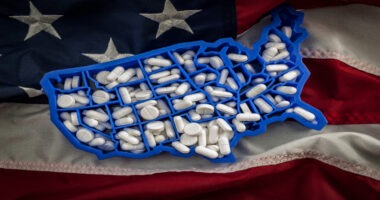Bio/Pharma Industry Radar: The In’s and Out’s of Cell & Gene Therapies
Takeda announced this week it is exiting the cell therapy market, and FDA issues three draft guidances to facilitate development of cell & gene therapies. How is the advanced therapies market faring thus far in 2025?
Patricia Van Arnum, Editorial Director, DCAT, pvanarnum@dcat.org
Market update: cell and gene therapies
Cell and gene therapies are a niche segment in the global bio/pharmaceutical market. To date, only two cell and gene therapies have reached blockbuster status (defined as achieving sales of $1 billion or more): Novartis’ Zolgensma (onasemnogene abeparvovec-xioi), an adeno-associated virus (AAV) vector-based gene therapy for treating spinal muscular atrophy, a genetic neuromuscular disorder, and Yescarta (axicabtagene ciloleucel) from Kite Pharma, a subsidiary of Gilead Sciences, a CAR T-cell therapy for treating certain forms of B-cell lymphoma and follicular lymphoma. Novartis’ Zolgensma posted 2024 global sales of $1.2 billion, and Gilead’s/Kite Pharma’s Yescarta posted 2024 global sales of $1.6 billion.
Zolgensma is one of two commercial advanced therapies for Novartis. The other is Kymriah (tisagenlecleucel), a CAR T-cell therapy for treating certain forms of acute lymphoblastic leukemia, large B-cell lymphoma, and follicular lymphoma. Kymriah was the first CAR T-cell therapy approved by the US Food and Drug Administration; it was approved in 2017 for treating acute lymphoblastic leukemia and received subsequent FDA approval for its other cancer indications. In 2024, it posted global sales of $443 million.
Cell and gene therapies are part of overall strategic focus of Novartis to invest in technology platforms that it expects will deliver future high-value medcines. These include two established platforms (chemistry and biotherapeutics) plus three advanced platforms (radioligand therapy, xRNA, and gene and cell therapy).
In addition to Yescarta, Gilead’s Kite has another commercial cell therapy, Tecartus (brexucabtagene autoleucel), a CAR T therapy for treating certain forms of mantle cell lymphoma and B-cell precursor acute lymphoblastic leukemia. It posted 2024 sales of $403 million.
Other noteworthy cell and gene therapies on a revenue basis from the large pharma companies include Johnson & Johnson’s/Legend Biotech’s Carvykti (ciltacabtagene autoleucel), a CAR T-cell therapy for treating multiple myeloma, which is nearing blockbuster status, with 2024 sales of $963 million. Also, Bristol-Myers Squibb’s Breyanzi (lisocabtagene maraleucel), a CAR T-cell therapy for treating certain types of B-cell lymphomas, posted 2024 sales of $747 million.
Roche’s/Sarepta Therapeutics’ Elevidys (delandistrogene moxeparvovec-rok), an AAV vector-based gene therapy, was nearing blockbuster status with 2024 sales of $821 million, but it experienced setbacks in 2025. The gene therapy is approved for treating Duchenne muscular dystrophy (DMD), a genetic disorder characterized by progressive muscle degeneration affecting the skeletal, respiratory, and cardiac muscle. The therapy is approved for treating DMD in patients who are ambulatory or non-ambulatory with specified confirmed DMD gene mutations. Roche formed a licensing pact in 2019 with Sarepta to develop Elevidys, worth up to $2.85 billion (an upfront payment and equity investment of $1.15 billion, up to $1.7 billion in regulatory and sales milestones, plus royalties on net sales).
In July (July 2025), the US Food and Drug Administration (FDA) recommended that Sarepta remove its voluntary pause and resume shipments of Elevidys for ambulatory individuals living with DMD following a review by FDA of the gene therapy’s safety data. The company had paused shipments to evaluate safety concerns following reporting three deaths of patients taking the therapy. Discussions between FDA and Sarepta are underway on next steps in the safety labeling process for acute liver injury/acute liver failure and risk-mitigation approach for non-ambulatory individuals living with DMD.
Other news: Takeda exits cell therapies
One large bio/pharma company leaving the cell-therapy market is Takeda, which announced this week (October 1, 2025) that as part of a strategic portfolio prioritization process, the company has made the decision to discontinue its cell-therapy efforts. Takeda will seek an external partner to leverage its cell-therapy platform technologies and to further advance the company’s research and clinic-ready programs in this field. The company has no current active clinical trials utilizing cell therapy technology. Takeda expects to recognize an impairment loss of approximately JPY 58.0 billion ($394 million) primarily related to intangible assets associated with its gamma delta T-cell therapy platform.
Big Pharma: M&A in advanced therapies
There have been two noteworthy mergers and acquisitions in the advanced therapy space thus far in 2025: AbbVie’s $2.1-billion acquisition of Capstan Therapeutics and Eli Lilly and Company’s $1.3-billion deal for acquiring Verve Therapeutics.
Capstan’s lead asset, CPTX2309, is a targeted lipid nanoparticle (tLNP) that delivers an mRNA encoding an anti-CD19 chimeric antigen receptor (CAR) to CD8-expressing cytotoxic T cells in vivo. It is currently in Phase I development for the treatment of B cell-mediated autoimmune diseases. Additionally, AbbVie acquired Capstan’s proprietary tLNP platform technology designed to deliver RNA payloads, such as mRNA, capable of engineering specific cell types in vivo.
In vivo CAR-T represents a potential new treatment modality in medicine embodying cell therapy with the accessibility and scalability of an off-the-shelf biologic. Mechanistically, B cells contribute to the pathogenesis of autoimmune diseases. CD19 is a cell surface receptor expressed on B cells and is a clinically validated target for B cell depletion using ex vivo CAR-T cell therapy in autoimmune diseases, according to information from AbbVie. CPTX2309, a product of Capstan’s proprietary technology platform that includes hepatic de-targeting, delivers an mRNA payload encoding an anti-CD19 CAR preferentially to reprogram CD8-expressing cytotoxic T cells. This process is achieved in vivo, without the need for lymphodepletion preconditioning and ex vivo manufacturing. The in vivo-modified CD8-expressing T cells will transiently express the CD19 CAR and deplete B cells in the periphery and tissues. Depletion of autoreactive antibody-producing pathogenic memory B cells and repopulation with naïve B cells, resulting in immune reset has the potential to prevent disease progression and induce clinical remission, according to information from AbbVie.
In July (July 2025), Lilly acquired Verve Therapeutics, a Boston-based clinical-stage bio/pharmaceutical company developing genetic medicines for cardiovascular disease, in a deal worth up to $1.3 billion ($1 billion upfront and $300 million in milestone payments). Verve is developing a pipeline of gene-editing medicines designed to address the drivers of atherosclerotic cardiovascular disease (ASCVD). Verve’s lead program (VERVE-102) is an in vivo gene-editing medicine targeting PCSK9, a gene linked to cholesterol levels and cardiovascular health. The treatment may be applicable for people who have heterozygous familial hypercholesterolemia, a subset of ASCVD that affects 1 in 250 people in the general population, as well as certain patients with premature coronary artery disease. VERVE-102 is being evaluated in a Phase Ib clinical trial study and has been granted fast-track designation by FDA.
Approvals of new cell and gene therapies in 2025
In terms of new approvals thus far in 2025, FDA has approved three advanced therapies. In August (August 2025), Precigen (Germantown, Maryland) received FDA approval for Papzimeos (zopapogene imadenovec-drba), a gene therapy for treating recurrent respiratory papillomatosis, a neoplastic disease of the upper and lower respiratory tracts caused by infection with the human papillomavirus (HPV) Type 6 or HPV 11.
In April (April 2025), Abeona Therapeutics (Cleveland, Ohio) received FDA approval for Zevaskyn (prademagene zamikeracel), a gene therapy for treating wounds in adult and pediatric patients with recessive dystrophic epidermolysis bullosa, a genetic skin disease. The product was expected to be available in third quarter of 2025.
In March (March 2025), Neurotech Pharmaceuticals (Cumberland, Rhode Island) received FDA approval for Enceltotm (revakinagene taroretcel-lwey), a cell therapy for treating macular telangiectasia Type 2, a neurodegenerative disease of the retina in adults that causes progressive and irreversible vision loss. It uses an encapsulated cell therapy technology designed to continually deliver therapeutic doses of ciliary neurotrophic factor to the retina to assist in slowing the progression of the disease. In August (August 2025), the company announced the first commercial manufacturing, shipment, and surgical procedure for the cell therapy.
Several companies are working with FDA after receiving Complete Response Letters for products that had been scheduled for FDA review this year (2025). In July (July 2025), Capricor Therapeutics (San Diego, California) received a Complete Response Letter from FDA for its biologics license application (BLA) for deramiocel, the company’s lead cell therapy candidate, for treating DMD-associated cardiomyopathy. Late last month (September 2025), the company provided an update following a recent Type A meeting with FDA to establish a path toward potential approval of deramiocel for the treatment of DMD, which includes the submission of additional clinical data for FDA to consider in its review of the product. All CMC items identified in the Complete Response Letter have been addressed, according to the company.
Ultragenyx (Novato, California) was seeking FDA review for its BLA for UX111 (rebisufligene etisparvovec), an AAV gene therapy for treating Sanfilippo syndrome Type A, a lysosomal storage disease that primarily affects the brain and is characterized by rapid neurodegeneration with onset in early childhood. The product was originally developed by Abeona Therapeutics and transferred to Ultragenyx to complete development. In July 2025, the FDA issued a Complete Response Letter for UX111 requesting additional information and improvements related to specific aspects of chemistry, manufacturing and controls (CMC) procedures and validation as well as observations from recently completed manufacturing facility inspections. The company is working with the FDA through a Type A meeting to agree on the planned resolution of the observations. Once agreement on the contents of a filing have been reached, the company expects to resubmit the BLA and anticipates up to a six-month review period to follow the resubmission. The CRL did not note any review issues related to the clinical data package nor clinical inspections.
In terms of upcoming regulatory submissions or review, in August (August 2025), Ultragenyx announced the initiation of a rolling submission of a BLA to FDA seeking approval for DTX401, an AAV gene therapy as a treatment for glycogen storage disease Type Ia. The company has submitted the non-clinical and clinical modules to FDA and plans to complete the full BLA, including submission of the CMC module in the fourth quarter of 2025.
Axogen (Alachua and Tampa, Florida) is seeking FDA approval for its tissue-engineered therapy, Avance nerve graft, a biologically active off-the-shelf processed human nerve allograft for bridging severed peripheral nerves without the co-morbidities associated with a second surgical site. The PDUFA goal date for review is December 5, 2025, following the inclusion of additional manufacturing and facility data from the company.
Regenxbio (Rockville, Maryldand) is advancing RGX-121 (clemidsogene lanparvovec), a potential one-time AAV therapeutic for the treatment of boys with MPS II, or Hunter Syndrome, a rare, X-linked recessive disease caused by a deficiency in the lysosomal enzyme leading to an accumulation of glycosaminoglycans, including heparan sulfate, in tissues that ultimately results in cell, tissue, and organ dysfunction. The gene therapy is designed to deliver the iduronate-2-sulfatase gene to the central nervous system. FDA is expected to make a decision on the application by February 8, 2026.
Earlier this year (March 2025), Fondazione Telethon (Milan, Italy) announced that it submitted to FDA its BLA for its gene therapy, etuvetidigene autotemcel, for the treatment of patients with Wiskott-Aldrich Syndrome (WAS), a rare genetic disease of the immune system. The gene therapy originated from research carried out by the San Raffaele-Telethon Institute for Gene Therapy (Milan, Italy).
FDA issues draft guidances
On the regulatory front, late last month (September 2025), the US Food and Drug Administration issued three draft guidances relating to cell and gene therapies.
The draft guidance, Expedited Programs for Regenerative Medicine Therapies for Serious Conditions, describes the expedited programs available to sponsors of regenerative medicine therapies for serious conditions, including those products designated as a regenerative medicine advanced therapy (RMAT). To that end, the guidance provides information about the provisions in the Cures Act regarding the use of the accelerated approval pathway for regenerative medicine therapies that have been granted designation as a RMAT. Finally, the guidance describes considerations in the clinical development of regenerative medicine therapies and opportunities for sponsors of such products to interact with the Center for Biologics Evaluation and Research (CBER) review staff. As a general matter, this guidance addresses regenerative medicine therapies regulated by CBER as biological products.
Another draft guidance, Innovative Designs for Clinical Trials of Cellular and Gene Therapy Products in Small Populations, provides recommendations to sponsors who are planning clinical trials of cell and gene therapy products intended for use in a disease or condition that affects a small population—generally one that meets the definition of a rare disease or condition. It describes FDA requirements and provides considerations for the use of various clinical trial designs and endpoints to generate clinical evidence to support product licensure. This guidance expands on principles described in FDA’s existing guidance documents related to this topic by providing additional recommendations for the planning, design, conduct, and analysis of cell and gene therapy trials to facilitate FDA’s assessment of product effectiveness.
The third draft guidance, Postapproval Methods to Capture Safety and Efficacy Data for Cell and Gene Therapy Products, discusses methods and approaches for capturing postapproval safety and efficacy data for cell and gene therapy products. Given the potential for long-lasting effects of cell and gene therapy products, and the generally limited number of participants treated in clinical trials conducted to support approval of cell and gene therapy products, postapproval monitoring is important for gathering data on product safety and effectiveness over time. This guidance does not address data collected for the purpose of expanding clinical indications.






